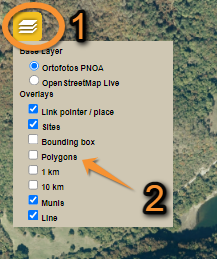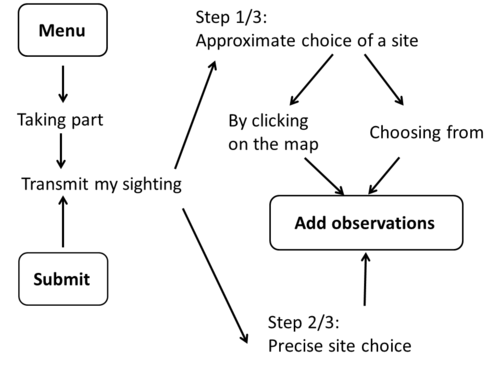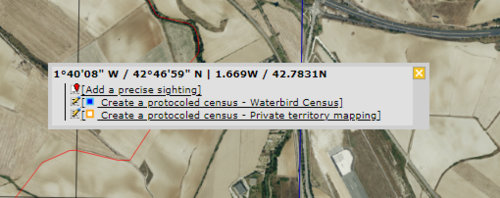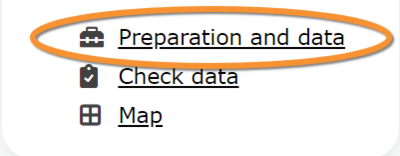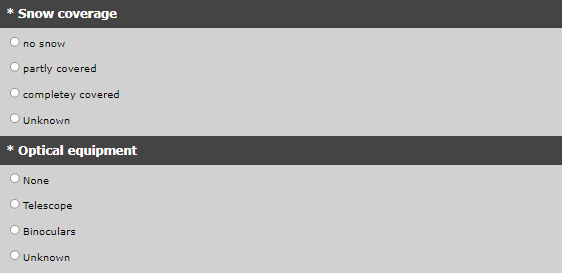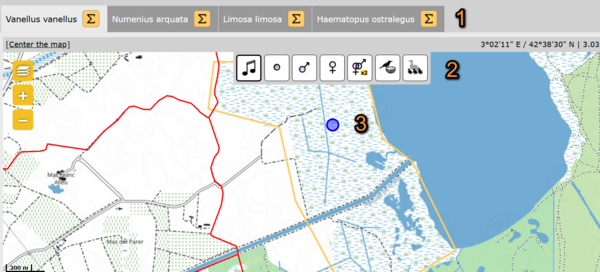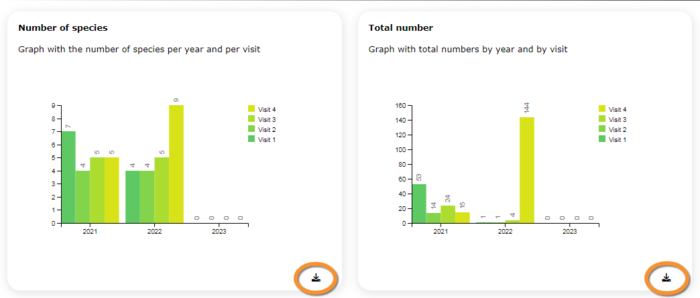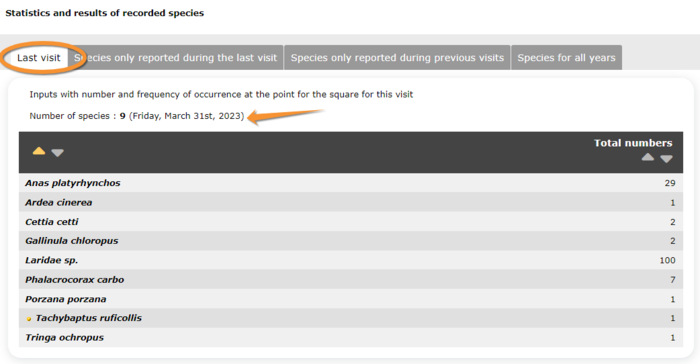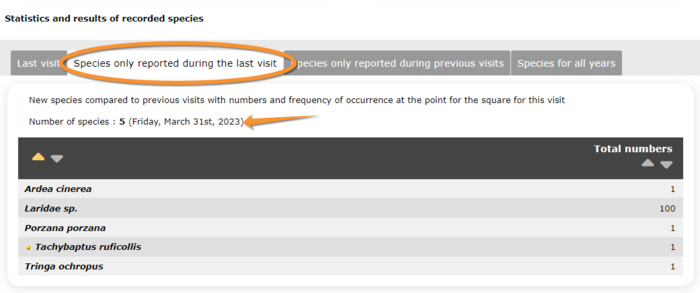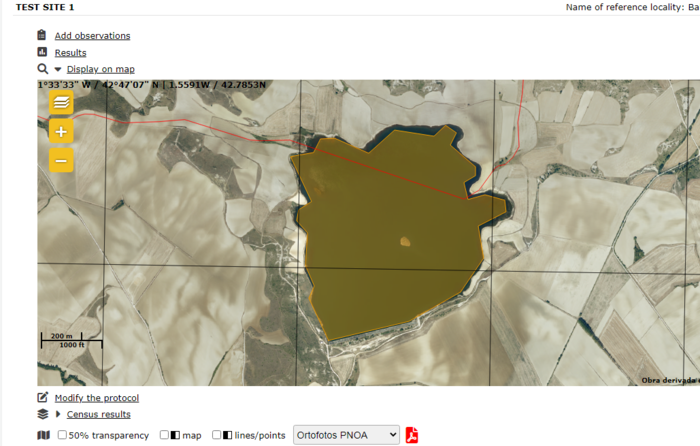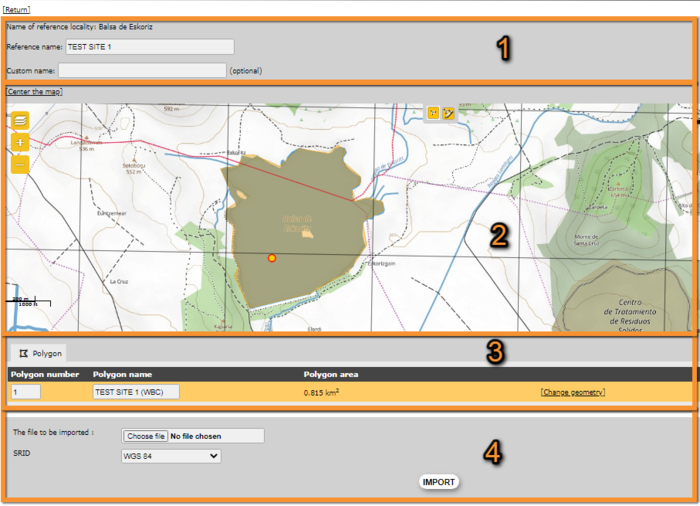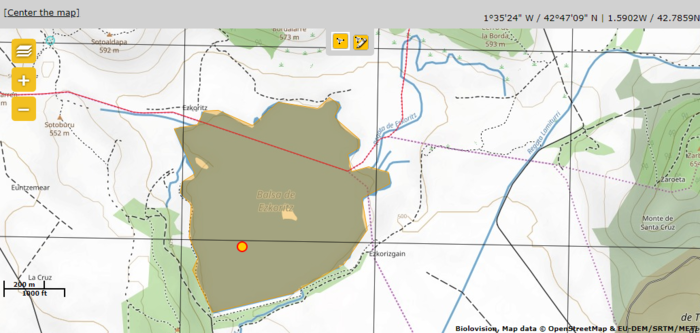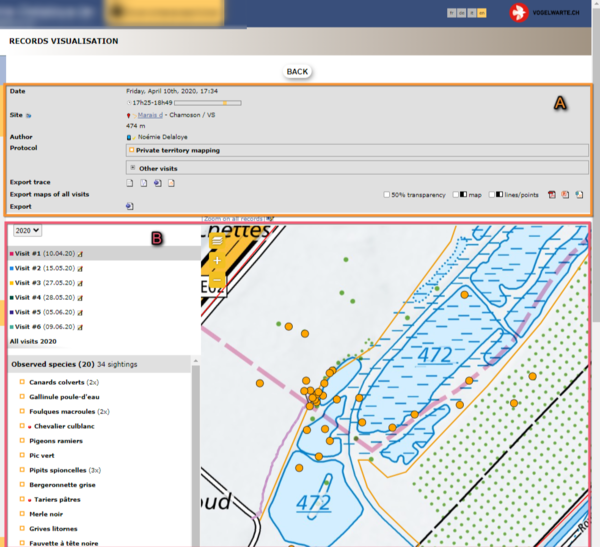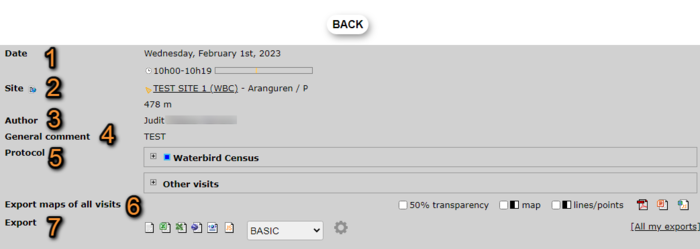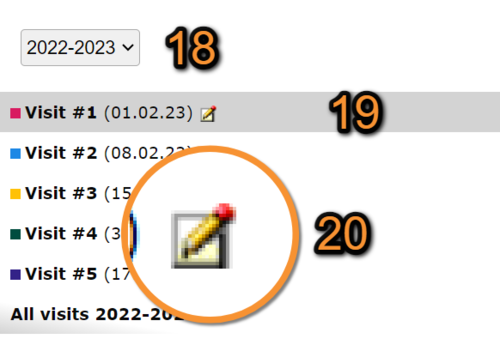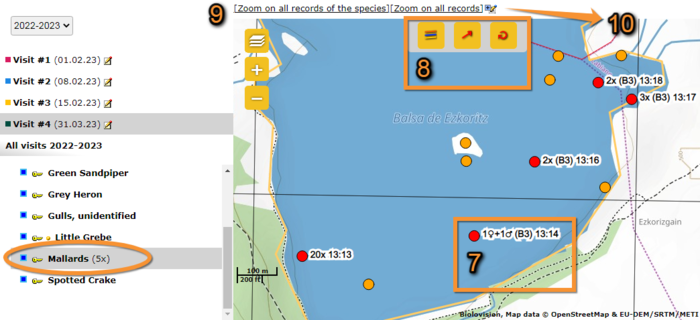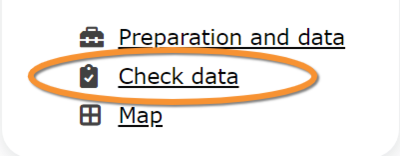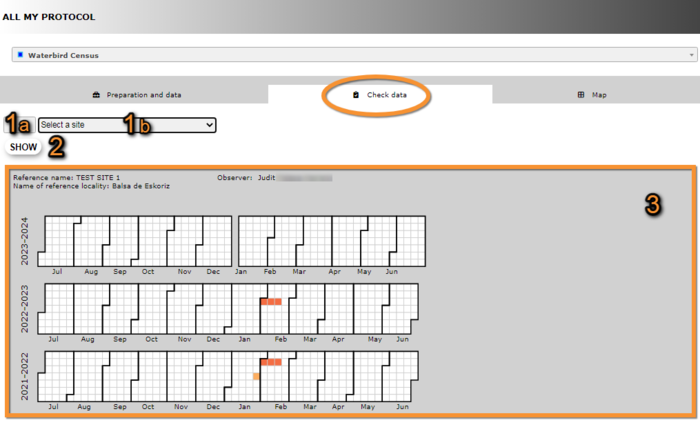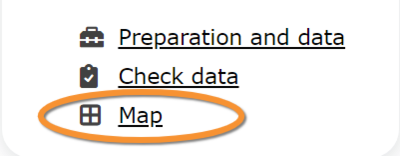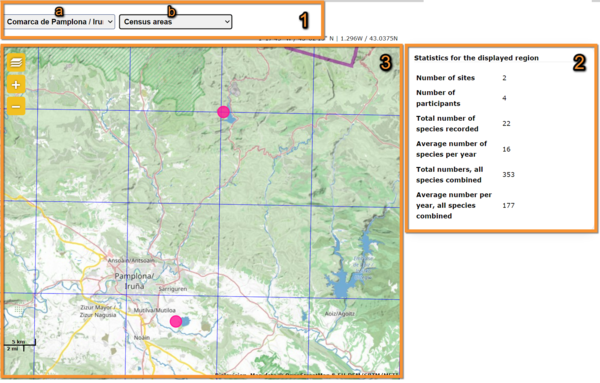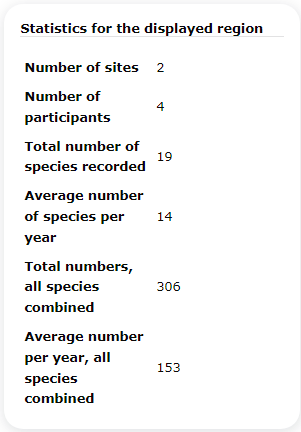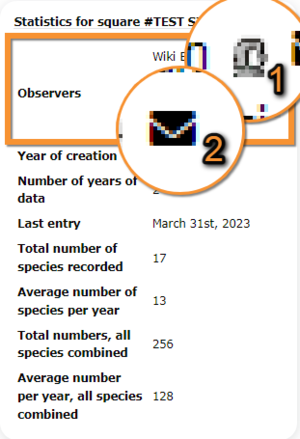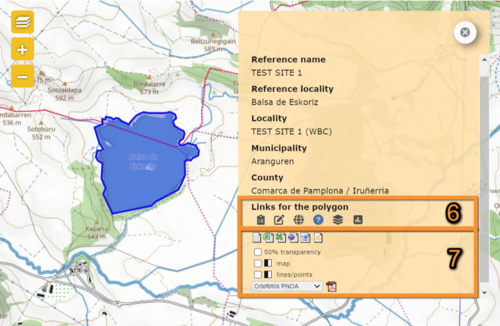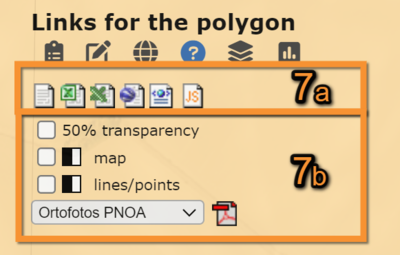Protocols web
Protocols are standardised ways of collecting data linked to a geometry (points, transects or polygons), taxonomic group and observation pressure.
The methodology to follow depends on the study's goal (see summary on Protocols' table).
A country administrator will grant you access if you meet certain criteria.
Not all protocols are available in all countries.
Contents
-
1 Accessing protocols
2 Preparation and data
- 2.1 Add observations
- 2.1.1 Starting the protocol
2.1.2 Entering observations
2.1.3 Ending the protocol
-
2.2 Results
- 2.2.1 Graph
2.2.2 Statistics and results of recorded species
-
2.3 Display on map
2.4 Modify the protocol
2.5 Census results
- 2.5.1 Protocol section
2.5.2 Observations section
2.5.3 Map section
-
2.6 Download map
-
3 Check data
4 Map
Protocols
-
· Acoustic data
· Bee-eater
· Bewick's Swan
· Birds of prey
· Black Grouse protocol
· CBBS in Protected areas
· Cirl Bunting
· CoBiMo
· Corncrake
· Grey Partridge
· Jackdaw
· Meadow birds
· MF (Monitoring of breeding birds in wetlands)
· MHB & BDM (Monitoring of common breeding birds Monitoring of biodiversity in Switzerland)*
· Other territory mapping
· Point count
· Private territory mapping
· Protocoled census
· Rock Ptarmigans protocol
· Rook
· Sand Martin
· SHOC
· Single nesting species (SNSP)
· SOCC
· STOC EPS
· STOC Montagne
· STOC ONF
· STOC Sites RNF
· STOC Sites
· VBS (Monitoring of breeding birds on military training areas)
· Waterbird census protocol
· Woodcock monitoring
· Woodpeckers
· Woodpecker territory
Accessing protocols
Access protocols from
Menu > Take part > All my protocols for an easy access to all functions you are allowed access to.
The easier way to access all functions of a protocol is through the protocol panel. Go to Menu > Take part > All my protocols. It lists all protocols you have access to in this local portal (see image below). Depending on your rights you could also access the protocol panel through the Administration section: Menu > Administration > Protocol administration > Protocol administration. Options vary depending on your rights (administrators have access to more functions).
However, there are other ways that in certain conditions may give access to some of the functions (see following sections).
Entering data
Enter data to a protocol from the protocol panel (see above) or as if submitting records.
To enter data as if submitting records,
1. access the page STEP 1/3 : Approximate choice of a site either from main menu or from Submit button.
2. Choose between:
· choosing from
- Only available if you have already entered data on this protocol and study site.
- Select a protocol, and a site (if there is more than one option for this protocol).
- Only available if you have already entered data on this protocol and study site.
· by clicking on the map.
- click anywhere within the polygon if you want to enter data on a protocol using polygons, or
- click on the protocol dot if you want to enter data on a protocol using dots.
- click anywhere within the polygon if you want to enter data on a protocol using polygons, or
NOTE: Show / hide polygons clicking on the layers icon on the top left corner of the map, and check the cell polygons (see image below). Polygons will be shown in yellow.
· Other options (by typing text, by choosing a municipality).
- Access to Step 2/3: Precise site choice. Scroll to your study site.
- Access to Step 2/3: Precise site choice. Scroll to your study site.
3. Select Add observations on the new window (see image below).
[Top to Accessing protocols]
[Back to Protocols]
Modify protocol
Modify protocols from
· the protocol panel. Go to Menu > Taking part > All my protocols > "Name of the protocol" > Preparation and data > Modify the protocol. See wiki section above, Local portal > Protocols > Accessing protocols.
· submitting records.
- 1. Access the page STEP 1/3 : Approximate choice of a site either from Main menu > Taking part or from Submit button (see image as an example).
- 1. Access the page STEP 1/3 : Approximate choice of a site either from Main menu > Taking part or from Submit button (see image as an example).
- 2. Scroll down to choosing from if you have already entered data at the site you want to modify; or by clicking on the map to select the site from the map.
- 2. Scroll down to choosing from if you have already entered data at the site you want to modify; or by clicking on the map to select the site from the map.
- 3. Click on the site to modify and select Modification of a protocoled census if you accessed from choosing from; or Modify the protocol if accessed from the map.
- 3. Click on the site to modify and select Modification of a protocoled census if you accessed from choosing from; or Modify the protocol if accessed from the map.
- NOTE: If the protocol you want to modify works with polygons, activate polygons from the layers icon at the top left corner (see image Showing polygons on the map) before clicking on the study site.
- NOTE: If the protocol you want to modify works with polygons, activate polygons from the layers icon at the top left corner (see image Showing polygons on the map) before clicking on the study site.
[Top to Accessing protocols]
[Back to Protocols]
Create protocol
Create a new area to survey.
Not all users have access to this function. It depends on the protocol, your local portal and your rights. If you do, access the map as if entering observations and click anywhere on the map (except on a dot or polygon). Click on Create a protocoled census. If you are allowed to create a new study site in more than one protocol, all options will be listed (see image below).
Enter data
- Menu > Taking part > All my protocol > Preparation and data > Add observations.
- Menu > Administration > Protocol administration > Protocol administration.
- Dashboard > Submit > Choosing from > "Name of the protocol" > "Site" > Add observations.
- Dashboard > Submit > By clicking on the map > Add observations.
- Menu > Taking part > Transmit my sighting > Choosing from > "Name of the protocol" > "Site" > Add observations.
- Menu > Taking part > Transmit my sighting > By clicking on the map > Add observations.
Modify protocol
- Menu > Taking part > All my protocol > Preparation and data > Modify the protocol.
- Dashboard > Submit > Choosing from > "Name of the protocol" > "Site" > Modification of a protocoled census .
- Dashboard > Submit > By clicking on the map > Modify the protocol.
- Menu > Taking part > Transmit my sighting > Choosing from > "Name of the protocol" > "Site" > Modification of a protocoled census.
- Menu > Taking part > Transmit my sighting > By clicking on the map > Modify the protocol.
Create a new protocol
- Dashboard > Submit > By clicking on the map > Create a protocoled census.
- Menu > Taking part > Transmit my sighting > By clicking on the map > Create a protocoled census.
[Top to Accessing protocols]
[Back to Protocols]
Preparation and data
Click on Preparation and data lists all sites available to the current profile and allows access to the functions listed hereafter for each place:
Protocol. Select site.
1. Change protocol by clicking on the active protocol name and selecting from the expandable menu.
2. Move to other sections within the protocol by selecting from the tabs above.
3. List of all sites you have access to under the selected protocol (number 1). When you do not have access to any site under the selected protocol, you will see a message "no count available".
2 Preparation and data
-
2.1 Add observations
- 2.1.1 Starting the protocol
2.1.2 Entering observations
2.1.3 Ending the protocol
-
2.2 Results
- 2.2.1 Graph
2.2.2 Statistics and results of recorded species
-
2.3 Display on map
2.4 Modify the protocol
2.5 Census results
- 2.5.1 Protocol section
2.5.2 Observations section
-
2.6 Download map
Add observations
Click on Add observations (see image below) in the site you need to enter data to.
Starting the protocol
Before entering observations, it is required to enter general parameters regarding the protocol.
Starting the protocol.
1. Site
2. Date
3. Starting time
4. Ending time
5. Comments
6. Hide records from the public
7. Location and visits
8. Parameters
1. Select site
If necessary, change site by selecting from the tabs. The active site is highlighted in yellow (see image above).
Choose date
- 2. Enter date
Choose from the expandable menu the date the survey took place.
- 3. Enter starting time
Type the time the census started.
- 4. Ending time
Type the time the census ended.
- 5. Enter comments
Choose one option from the tabs on top (5a) and type a comment (5b). Note the number of tabs and the information required may differ from country to country:
· Comment: if the comment will refer to a general observation,
· Additional observer: if you name other observer/s participating in the census,
· Important changes: to note important changes from your previous visit, like noise, pollution or construction work,
· Impacts: record any impact taking place during the survey,
· Incidents: report any incident that may have happened during the count.
- 6. Hide all records from the public
Check if you do not want other users to see your records.
Location and visits
- 7. Count number
Some protocols have certain restrictions regarding the number or dates to conduct surveys. If the protocol requires it, select from the expandable menu which visit your data corresponds to. If the protocol does not require this field, you will only see Reference name and Reference locality.
8. Parameters
Enter parameters required for your polygon. Note fields and the order in which they appear may differ from country to country. You may not encounter all possible fields described underneath. Expand the table below to see all possibilities.
Fields marked with an asterisk are mandatory.
| Parameters | ||||||||||
|---|---|---|---|---|---|---|---|---|---|---|
| Name | Description | |||||||||
| Acoustic number | Indicate the acoustic number. This information will be asked when entering data. | |||||||||
| Acoustic number detail | Provide details about the acoustic number. This information will be asked when entering data. | |||||||||
| Activity of the individual | Indicate the activity of the individual. This information will be asked when entering data. | |||||||||
| Additional observer | Indicate if you are accompanied by someone whose observations are also recorded. | |||||||||
| Appearance of udders | Indicate the appearance of udders. | |||||||||
| Calcar | Enter information about the calcar. | |||||||||
| Capture method | Indicate how the animal was caught. | |||||||||
| Census not done | Press at the end of the page if the census did not take place. Leave a reason in Comments. | |||||||||
| Chin pad (Plecotus) | Indicate the hair colour. | |||||||||
| Cloud cover | Indicate if there were clouds. | |||||||||
| Cm3 (mm) | Indicate the length of cm3. | |||||||||
| Color of oral glands | Indicate the colour of oral glands. | |||||||||
| Comment | You may enter a comment if you find it appropriate. | |||||||||
| Conditions in general | Choose how are surveying conditions overall regarding weather and disturbances, and may be asked to indicate on next section the reason if surveying conditions are not good. | |||||||||
| Conditions (notes) | Leave a note regarding conditions if necessary. | |||||||||
| Count method | Indicate if you are surveying from the ground, the air, the water, a different way, or if it is unknown. | |||||||||
| Count paid | Indicate if the count is paid for or not. | |||||||||
| Count type | Tick roost count if you are counting roosting birds, or during day otherwise. | |||||||||
| Counting mammals? | Indicate if besides the compulsory taxonomic group, you also counted mammals. | |||||||||
| Coverage | Indicate how much of the designated survey area is covered in the survey. | |||||||||
| Coverage (notes) | Leave any comment regarding the coverage. | |||||||||
| Determination methods | Indicate the determination method used. This information will be asked when entering data. | |||||||||
| Drone used | Indicate if drones were used during the survey. | |||||||||
| Ear | Enter information about the ear. | |||||||||
| Ear width (mm) | Type the width of the ear in millimeters. | |||||||||
| Foot | Enter information about the foot. | |||||||||
| Foot hair (Plecotus) | Indicate the presence of hairs on the foot. | |||||||||
| Forearm (mm) | Type the length of the forearm in millimeters. | |||||||||
| Fused wing cells (Pipistrellus) | Merge the information from wing cells. | |||||||||
| Habitat | Choose the most accurate habitat from the expandable menu. | |||||||||
| Hair color | Indicate the hair colour. | |||||||||
| Ice | Indicate the percentage of water surface that is frozen. | |||||||||
| Important changes | Indicate if there have been major changes since your last visit. | |||||||||
| Intact nests | Type number of intact nests. This information will be asked when entering data. |
|||||||||
| Means of transport | ||||||||||
| Mowing/Harvest | Indicate the surface that has been harvested or mown. | |||||||||
| Nasal leaf length | Indicate the length of the nasal leaf. | |||||||||
| Nest location | Select from the expandable menu the location of the nest. | |||||||||
| Net / harp-trap detail | Add details on certain types of traps: Nets and harp-traps. | |||||||||
| Neutralised time | Time to be removed from the official census time (like a pause) | |||||||||
| Number of canoes/kayaks | Enter number. | |||||||||
| Number of fishing boats | Enter number. | |||||||||
| Number of motor boats | Enter number. | |||||||||
| Number of nests occupied by other species | Type number of nests occupied by species other than the ones counted in the current protocol. This information will be asked when entering data. |
|||||||||
| Number of persons on shore | Enter number. | |||||||||
| Number of rowing boats | Enter number. | |||||||||
| Number of sailing boats | Enter number. | |||||||||
| Number of sports divers | Enter number. | |||||||||
| Number of stand up paddlers | Enter number. | |||||||||
| Number of surfers | Enter number. | |||||||||
| Occupied nests | Type number of occupied nests. This information will be asked when entering data. |
|||||||||
| Optical equipment | Indicate which equipment you are using for the survey, if any. Note you can only choose one option. | |||||||||
| Ossification level of the epiphyses at the joint of the phalanges | Indicate the level of ossification of the epiphyses at the joint of the phalanges. | |||||||||
| Playback | Check the species names for which playback will be played during the survey. | |||||||||
| Potential breeding pairs | Type the number of breeding pairs. This information will be asked when entering data. |
|||||||||
| Rain | Indicate if there was any rain. | |||||||||
| Reason(s) for moderate / bad conditions | If general conditions indicated above are not good, open the expandable menu and choose the reason (see image below). Only one option is possible: choose the one that is closest to the reality. | |||||||||
| Size of the epididymis | Indicate the size of the epididymis. | |||||||||
| Size of oral glands | Indicate the size of the oral glands. | |||||||||
| Social vocalisation type | Indicate the type of vocalisation. This information will be asked when entering data. | |||||||||
| Snow/Snow coverage | Indicate the proportion of snow cover. | |||||||||
| Sound played | Indicate if you used playback to detect the species by sliding the mark on/off. | |||||||||
| Suspected nests | Type number of suspected nests. This information will be asked when entering data. |
|||||||||
| Tail | Enter information about the tail. | |||||||||
| Temperature | Indicate approximate temperature. | |||||||||
| Temporary shallow water bodies | Indicate the frequency of water bodies. | |||||||||
| Testicles size | Indicate the size of the testicles. | |||||||||
| Thumb | Enter information about the thumb. | |||||||||
| Tibia | Enter information about the tibia. | |||||||||
| Tragus | Enter information about the tragus. | |||||||||
| Tragus widht (mm) | Indicate the width of the tragus. | |||||||||
| Vaginal tunic color | Indicate the colour of the vaginal tunic. | |||||||||
| Visibility | Indicate the approximate distance within which it is possible to identify species, or an overall description. | |||||||||
| Water level | Indicate the water level. | |||||||||
| Waves | Indicate how the waves are. | |||||||||
| Weight (g) | Enter the weight of the animal. | |||||||||
| Wind | Indicate if there was any wind. | |||||||||
| 1P3D | Enter information about 1P3D. | |||||||||
| 1P4D | Enter information about 1P4D. | |||||||||
| 1P5D | Enter information about 1P5D. | |||||||||
| 2nd finger | Enter information about the second finger. | |||||||||
| 2nd metacarpus | Enter information about the second metacarpus. | |||||||||
| 2P3D | Enter information about 2P3D. | |||||||||
| 2P4D | Enter information about 2P4D. | |||||||||
| 2P5D | Enter information about 2P5D. | |||||||||
| 3rd finger | Enter information about the third finger. | |||||||||
| 3rd metacarpus | Enter information about the third metacarpus. | |||||||||
| 4th finger | Enter information about the fourth finger. | |||||||||
| 4th metacarpus | Enter information about the fourth metacarpus. | |||||||||
| 5th finger | Enter information about the fifth finger. | |||||||||
| 5th metacarpus | Enter information about the fifth metacarpus. | |||||||||
9. Start entering data
Options may differ from protocol to protocol but can be summarised as:
- NEXT: Continue entering data normally.
- NEXT: Continue entering data normally.
- CHOOSE A LIST TO ENTER DATA: Some protocols make a distinction between a Basic and an Extended list (see image Continue to enter data as an example).
- CHOOSE A LIST TO ENTER DATA: Some protocols make a distinction between a Basic and an Extended list (see image Continue to enter data as an example).
- BASIC LIST: Select to load a pre configured species list strictly related to the protocol (ie. waterbirds). It will facilitate entering data. See an example of how it may look like in image Example of a basic list compared to an Example of extended list. Which species belong to a basic list is determined by each local portal and may differ from one to another.
- BASIC LIST: Select to load a pre configured species list strictly related to the protocol (ie. waterbirds). It will facilitate entering data. See an example of how it may look like in image Example of a basic list compared to an Example of extended list. Which species belong to a basic list is determined by each local portal and may differ from one to another.
- EXTENDED LIST: Select to load a pre configured species list strictly related to the protocol (ie. waterbirds) along with other related ones (ie. reed-living species). It will facilitate entering data. See an example of how it may look like in image Example of extended list. Species included in a basic list and an extended list are determined by each local portal and may differ from country to country.
- EXTENDED LIST: Select to load a pre configured species list strictly related to the protocol (ie. waterbirds) along with other related ones (ie. reed-living species). It will facilitate entering data. See an example of how it may look like in image Example of extended list. Species included in a basic list and an extended list are determined by each local portal and may differ from country to country.
- If the administrator of the protocol did not prepare any pre configured list for this protocol, you will not be given any list of species to enter from; but you will still have to choose a list option in this section.
- If the administrator of the protocol did not prepare any pre configured list for this protocol, you will not be given any list of species to enter from; but you will still have to choose a list option in this section.
- NO SPECIES / INDIVIDUALS WERE SEEN: Indicate if your survey did not provide any data. You will be taken to directly to end the protocol. Surveys with no species are also important results! It means you followed the established methodology, and therefore your survey is valid, but no birds were present. They can indicate major population changes and are of extreme importance for conservation purposes.
- NO SPECIES / INDIVIDUALS WERE SEEN: Indicate if your survey did not provide any data. You will be taken to directly to end the protocol. Surveys with no species are also important results! It means you followed the established methodology, and therefore your survey is valid, but no birds were present. They can indicate major population changes and are of extreme importance for conservation purposes.
- ENTRY WITH LIST OF SPECIES ALREADY SEEN: Select to load a list with species previously recorded for this protocol at this study site.
- ENTRY WITH LIST OF SPECIES ALREADY SEEN: Select to load a list with species previously recorded for this protocol at this study site.
- ENTRY WITH LIST OF THE MOST FREQUENT SPECIES: Select to load a list with species recorded frequently for this protocol at this study site.
- ENTRY WITH LIST OF THE MOST FREQUENT SPECIES: Select to load a list with species recorded frequently for this protocol at this study site.
- CENSUS NOT DONE: Indicate if you did not survey a certain point, transect or polygon for the protocol, but you did survey another points of the same protocol.
- CENSUS NOT DONE: Indicate if you did not survey a certain point, transect or polygon for the protocol, but you did survey another points of the same protocol.
|
Surveys with no species are also important results! Please submit them. It means you followed the established methodology but no birds were present. It can be due to methodology, disturbance, pollution or other major population changes and may be of extreme importance for conservation purposes. |
[Top to Add observations]
[Top to Preparation and data]
[Back to Protocols]
Entering observations
According to the protocol, there are different ways to enter observations to the protocol.
Click on the protocol that most resemble your protocol to see details.
All existing models can be grouped in:
·Number of individuals: those requiring to enter only the number of individuals of each species observed.
·Distance of individuals: those which besides the number of individuals, need to be grouped according to the distance to the observer.
·Position of individuals: those that require positioning the individual on a map.
·Acoustic data: it is special and only available for Acoustic data protocol.
·Number of passages: those that group the observations according to the census.
·Count per sections: those in which the study area (transect) is separated in sections.
Additional information can always be entered besides the minimum requirements:
·Use ![]() to open additional information panel.
to open additional information panel.
·See Web interface > Local portal > Step 3: Transmit my sighting > If accessed from add sightings on this locality or add precise location > Additional information for more information.
| Type of protocol | Description | Protocol |
|---|---|---|
 |
Number of individuals | Point count, Protocoled census, Waterbird census |
 |
Distance of individuals | SHOC, SHOC Sites, SHOC Sites RNF, STOC EPS, STOC Montagne, STOC ONF, STOC Sites, STOC Sites RNF |
 |
Position of individuals | Bee-eater, Black Grouse, Cirl Bunting, Corncrake, Jackdaw, Meadow birds, Rock Ptarmigans, Rook, Sand Martin, Woodpeckers |
 |
Acoustic data | Acoustic data |
 |
Number of passages | Woodcock |
 |
Count per sections | SOCC |
If the protocol you are looking for is not on the table, it may not allow entering observation via local portal. Use NaturaList instead.
Number of individuals
· Requires entering species and number of individuals.
· It may also require Count precision, depending on the protocol.
· It may also require Atlas code, depending on local portal, species and time of year.
Number of individuals model.
1. Select precision count from the expandable menu.
2. Type number of individuals of the selected species.
3. Select Atlas code from the expandable menu.
4. Open the additional information panel.
5. Report a new species not on the list: Type the species name or part of it on the left, and select species name on the expandable menu on the right.
· A list may be already given or the observer needs to indicate the species, depending on the protocol and the local portal. Select the option on previous screen:
· CONTINUE WITH THE BASIC LIST: Contains only species relevant to the protocol.
· CONTINUE WITH THE EXTENDED LIST: Contains species relevant to the protocol and other related ones.
· Open the additional information panel to provide more information.
Distance of individuals
· Requires indicating number of individuals of each species at its distance (in range) from observer.
· It may also require Atlas code depending on the local portal, the species and the time of year.
· A list may be already given or the observer needs to indicate the species, depending on the protocol and the local portal. Select the option on previous screen:
· NEXT: Empty list. The observer types all species names.
· ENTRY WITH LIST OF SPECIES ALREADY OBSERVED: The list given contains all species the observer has reported in previous visits of this protocol.
· ENTRY WITH LIST OF THE MOST FREQUENT SPECIES: The list given contains only the most frequent species reported by the observer on this protocol.
· BLANK DAILY FORM: No list is given. The observer types all species names.
· Open the additional information panel to provide more information.
Position of individuals
· Requires positioning the individual on a map before entering any other data.
1. Select the species from the tabs above, when more than one species is given.
2. Select behaviour of the individual/s. Its corresponding Atlas code will automatically load.
See Mobile interface > Additional information panel > Entering records > Entering additional information on mapping protocols for more information.
3. Place observation on the map.
See Web interface > Local portals > Navigating the map if necessary for more on navigating the map.
· Depending on the protocol, the map can include a radius around the observer.
See Mobile interface > Navigating the map > Radius to know more about radius.
4. Fill in information under the map.
Note the dot colour on the top right corner matches the colour of observation on the map.
Use ![]() to delete observation.
to delete observation.
Design differs from protocol to protocol but can include:
· number of individuals at the selected position
· age and sex classes of observation
· atlas code
· altitude
· Nest information
| Intact nests | Type number of intact nests. |
| Nest location | Select next position from the expandable menu. |
| Occupied nests | Type number of occupied nests. |
| Potential breeding pairs | Type number of breeding pairs. |
Short additional information panel. Details.
1. Enter number of individuals: Type number on the left and select count precision from the expandable menu on the right.
2. Altitude: Type new altitud if necessary.
3. Atlas code: Select a new atlas code from the expandable menu. Meaning of the selected code is indicated by the field side.
4. Age/sex classes: Type number of individuals on the left hand field and select from the expandable menus age and sex of typed individuals. Select circumstances (behaviour) from the expandable menu, when asked (not available in all protocols).
· Open the additional information panel to provide more information.
Acoustic data
· Specific for Acoustic data protocol.
· No other protocol follows this model.
· See Acoustic data protocol for details.
Number of passages
· Requires entering information about individuals flying over.
Use ![]() to delete observation.
to delete observation.
Count per sections
· Requires separating the observations by transect section.
1. Enter species name, or part of it, on the let, and select name from the expandable menu on the right.
2. Type number of individuals of the selected species on the section of protocol that corresponds.
[Top to Add observations]
[Top to Preparation and data]
[Back to Protocols]
Ending the protocol
When all species are recorded, indicate
- 1. I recorded all species of the program if you identified and recorded all species seen or heard that are of interest to the protocol, or
- 2. I recorded all species (=full observation list) if besides all species of interest to the protocol, you also identified and recorded all other species seen or heard. Note you can only record in this list species identified within the designated study area. Any species recorded outside of the study area should be submitted as an individual record.
Then, you will be taken to set parameters to start a new protocol.
[Top to Add observations]
[Top to Preparation and data]
[Back to Protocols]
Results
See some general statistics about your surveys results on a page by graphs, list and list plus percent of frequency occurrence .
To see specific counts results go to Census results or Display on map.
Graphs Number of species and Total number :
Number of species
Represents the number of species recorded during each visit.
In the example in the image above, the user recorded 7 species during the first visit of 2021, 4 on the second visit, and 5 on each of the last two. Equally, no species were recorded in any of the 4 visits of 2023.
Click on the download icon (encircled in picture) to download the data as a .CVS file, that can be uploaded into R software.
Total number
Represents the number of individuals recorded in each visit, pulling all species together.
From the example in the image above, the user recorded 53 individuals on the first visit of 2021, 14 on the second and so on, and none in any of the visits in 2023.
Click on the download icon (encircled in picture) to download the data as a .CVS file, that can be uploaded into R software.
Statistics and results of recorded species:
- Last visit
List of species recorded at the selected site during the last visit. Use arrows under titles to alternate between ascending and descending order (see image as an example). Orange arrow in image indicates the date of last visit.
- Species only reported during the last visit
List of species recorded only during the last visit and no other visit. Use arrows under titles to alternate between ascending and descending order (see image as an example). Orange arrow in image indicates the date of the last visit.
- Species only reported during previous visits
List of species that were not reported during the last visit but were seen in one of the previous ones. Use arrows under titles to alternate between ascending and descending order (see image as an example). Orange arrow in image indicates the date of last visit.
- Species for all years
List of all species reported by the user at this site, and the frequency of occurence. Use arrows under titles to alternate between ascending and descending order (see image as an example). Orange arrow in image indicates the date of last visit.
Protocol. Results for all species.
Average frequence of occurrence: Proportion of visits in which the species was recorded.
For example, Anas platyrhynchos has been recorded in all visits at this site, Anas clypeata has only been recorded in half of them, and Anas acuta only in a 12.5% of them.
Total numbers: Total number of recordings for the species across all visits and years for the site.
[Top to Results]
[Top to Preparation and data]
[Back to Protocols]
Display on map
For the selected site, see the polygon, line or point to survey on a map. To know how to navigate the map, refer to wiki section Web interface > Navigating the map.
Here you can:
- Visualize your polygon/transect/point to count
- Generate a printable map version of your census area
[Top to Display on map]
[Top to Preparation and data]
[Back to Protocols]
Modify the protocol
Modify the site to survey. Only users that have been granted this right will have access to the section.
- 1. Modify name
Add or amend site custom name. Site reference name can only be changed by administrators.
Protocol. Modify site name.
Name of reference locality: Location under which all objects from the protocol are attached to. It is determined by administrators when creating the site and cannot be changed afterwards.
Reference name: Site name officially defined for the protocol, can be a number, name or any other code.
Custom name: Name under which the site is also known or name the observer wants to give to the site.
- 2. Modify polygon, line or point
Change the shape of the polygon, line or position of the point. See Web interface > Navigating the map to know how to move around the map, and Web interface > Geometry editor to know how to draw or modify a polygon, line or point.
- 3. Download polygon, line or point
Download the polygon, line or point as a shapefile, to use in the future or to modify it with an external GIS program.
Protocol. Download polygon/transect/point.
Polygon/transect/point number: indicates the site the entry represents in locations with more than one study site. It can be a polygon, a line or a point.
Polygon/transect/point name: site name. It can be a polygon, a line or a point.
Polygon area: area of the polygon.
5. Change geometry: Click to upload a new shapefile. It will open a menu identical to next subsection (see image).
6. Export: Click on the icon to download the corresponding polygon, line or point as a shapefile. Modify it on a GIS and upload (see next subsection to upload).
- 4. Upload site
Import an existing polygon, line or point.
[Top to Modify the protocol]
[Top to Preparation and data]
[Back to Protocols]
Census results
Click on Census results to see all available years with data for this site (see image below). Select the one to visualise.
Sites with no records do not appear on the menu. You can only see your own records, unless you are a protocol administrator. To know more about administrators, see wiki section Administration.
A new window will show all your records at the selected site. A grey section on top contains general information about this particular count, while the bottom part refers to the observations.
1. Protocol section
General information about the selected visit at the selected site.
Browsing protocol results.
4. Date
5. Site
6. Author
7. General comment
8. Protocol
9. Export maps of all visits
10.Export data
- 4. Date
Date and time of selected survey. Notice the bar representing the extent of the day, and the yellow marking indicating time of day the survey took place (see image Time of survey).
- 5. Site
Site of selected survey.
Browsing protocol results. Site.
11. Click on site name to open a new window with more information about the site, and its map.
12. Altitude.
13. Click on icon to access all observations associated with the site as in the Search engine.
- 6. Author
Name of observer. If you are an administrator, click on name to access their personal card. A cell phone icon in front of the name indicates the data has been submitted from NaturaList.
- 7. General comment
Comment about the selected survey, when existing.
- 8. Protocol
Protocol summary.
14. Protocol summary: Click on the + sign to expand the panel, and on the - sign to collapse when opened (encircled on image).
15. List of all visits: Click on the + sign to expand the panel, and on the - sign to collapse when opened (encircled on image).
- 9. Export maps of all visits
Download maps as described in wiki section Web interface > Protocols > Preparation and data > Download map below.
- 10. Export data
Export your data as described in wiki section Web interface > Exporting your data.
[Top to Census results]
[Back to Preparation and data]
[Back to Protocols]
2. Observations section
List of all visits and their results.
- 16. Visits
List of al visits to the site for the selected period. Use the bar on the right to see all visits if necessary.
Protocol. Browsing visits.
18. Select from the expandable menu a different period if necessary.
19. Select the visit you would like to visualise. The selected visit will be highlighted in grey.
20. Click on notebook icon to modify / visualise the selected visit.
NOTE:
a danger sign besides the census date indicates census were entered in uncorrelated dates even when the date introduced is the correct one.
Do enter census in chronological order to avoid this issue.
- 17. Species
List of species recorded on the selected visit to this site. If necessary, move the right hand bar to see the full list. See wiki section Various > Symbols cheatsheet to know correspondence of symbols next to species names.
If your observations were submitted through the website, records are associated to a protocol polygon but their precise location within the polygon is unknown. No observations will be displayed in the map (see image as an example).
If your observations were submitted through NaturaList, records are displayed on the map at their precise location within the polygon (see image as an example).
Entering observations through the local portal: Observations will not be represented on the Map section.
Entering observations through NaturaList: Observations will be represented on the Map section at their recorded position (see image Protocol. Records visualisation on the map on next section).
[Top to Census results]
[Back to Preparation and data]
[Back to Protocols]
3. Map section
See the polygon of the surveyed site and all observations for the selected visit, if they were submitted through NaturaList. To know how to navigate the map, visit wiki section Web interface > Navigating the map.
To better visualise observations, select a species from the Observed species section left of the map (see sub-section 2. Species above). All records of the selected species are displayed in red, while all others continue being displayed in yellow.
Protocol. Records visualisation on the map.
21. Summary of observations
22. Additional functions
23. Zoom
24. Add species to the form
- 21. Summary of observations
- 21. Summary of observations
Details associated to the selected observation are summarised next to its position (represented by a red dot). To see how to interpret it, refer to wiki section Mobile interface > Understanding a summary of observations.
- 22. Additional functions
- 22. Additional functions
Click on any record to open a menu with additional functions. Red dots indicate observations where additional functions apply to. Note not all protocols allow all functions and therefore, some protocols may not display all icons.
Add or modify additional information in the local portal.
25. Individuals of the same species: Select/deselect all individuals of the same species, and show their details. If a relationship between the sightings have been recorded, it will be shown/hidden here.
26. Flight direction: Adds flight direction if necessary. To add flight direction,
-click on the arrow icon,
-select the individual you want to add flight direction to (it becomes red),
-move the mouse to match the blue round (top) to the flight direction (bottom). See example.
27. Circle flight: Circle flight
28. Access details and edit: Access record details including information about the list and other species from the same list, as if from Home > Main menu (left column) > All my observations. The individual the function applies to is indicated by a
blue circle around it.
29. Delete: Delete the selected record. You will be prompted to confirm.
- 23. Zoom
- 23. Zoom
Select to zoom and center observations. Choose between
Zoom on all records of the species to see and center all records of the selected species.
Zoom on all records to see and center all records of this visit. When selected this option, all records will be displayed even when they were previously hidden.
- 24. Add a species to the form
- 24. Add a species to the form
Add a new entry to the selected visit. Enter information as for a list. See wiki section Web interface > Submitting records > Step 3/3: Submit my sighting > As if accessed from a list > List section.
[Top to Census results]
[Back to Preparation and data]
[Back to Protocols]
Download map
It is possible to download the map, for example if you cannot record observations on your device while in the field, or to keep a second copy of your data for dataproof. You can choose the map layer (available layers depend on the local portal), the transparency of the map and the colour mode (colour vs. black and white), in any combination, and download as a pdf file.
Note final design depends on the protocol and the local portal.
The PDF file displays:
- the map of your protocol area with the polygon, points and/or transects to survey
- a QR code that, when scanned, drives you directly to the place on the map while entering data on the web
- the name of the local portal the map comes from
- the GPS coordinates, Atitude, Reference place name for the polygon, points or transect, and Reference name
Protocol. Download map.
50% transparency: Check to print the map with 50% of transparency (see image Example 50% transparency, default map on top, transparent map below).
Map: Check to print the map in black and white (see image Example black and white, default map on top, black and white below). It may help to reduce ink and is compatible to back and white printers.
Lines/points: Check to delimit the polygon to survey with dots instead of lines (see image Example lines and points, map with lines on top (defalut option), with points below).
1. Choose from the expandable menu the map layer you would like to print.
2. Click on pdf icon to download the map as a pdf.
[Top to Download map]
[Back to Preparation and data]
[Back to Protocols]
Check data
Calendar showing visits to different sites and number of species detected.
- 1. Select site
Select a site by typing the name, or part of the name, in the left field (1a) and/or selecting from the expandable menu on the right (1b). Click 'Select a site' from the expandable menu to revert the selection and visualise all site again.
- 2. SHOW
Click to apply selection.
- 3. Graphic area
See a calendar with dates in which surveys took place (colored cells). Move pointer on any colored cell to see the date the census took place and the number of species recorded. The darker the colour, the larger number of species.
Click on any coloured cell to see on a new window a list of species recorded on that date. Refer to wiki section Web interface > Codes and symbols to understand the meaning of the different symbols associated to each observation.
[Top to Check data]
[Back to Protocols]
Map
Map and statistics for the site. You can only see your own site/s unless you are a user with special rights or an administrator.
- 1. Select site
Select area on the left hand expandable menu (1a) and/or study site on the right hand menu (1b).
· 'Country' on the area menu refers to the whole area covered by the local portal you are in.
· Check 'My census areas' to automatically select only all your census areas.
- 2. Statistics
Basic statistics about the selected area or site/sites.
- Statistics for the displayed region
- Statistics for the displayed region
Statistics when more than one site is included in the selected area. Data from all sites are pooled in the results.
- Statistics for square
- Statistics for square
Statistics when only one site is included in the search. It includes names of all users involved, and it is possible to contact them (icon 4) and/see all records associated by the user (icon 5).
- 3. Map area
Map with the polygons/transects/points to survey highlighted in pink. Visit wiki section Web interface > Navigating the map to know how to navigate the map.
Select a site on the right hand expandable menu (see 1b) when there is more than one site per area.
Click on the desired polygon to see details (see image below).
- 6. Quick links
Get quick access to other functions of the protocol. Icon may be grouped per polygon/transect/point/square and are protocol dependent. You may not encounter all of them in each protocol.
| Add observations Add further observations to this site or any other as described in wiki section Web interface > Protocols > Preparation and data > Add observations. |
|
| All site data See all records associated to the site. From this screen (see image below) you can access other data as in the Search engine tool. |
|
|
| |
| Data visualisation See all protocols associated to this site, as described in Protocols > Preparation and data > Census results. |
|
| List of records to be checked See all records associated to the site needing verification. This icon is only available to administrators. |
|
| Modify the protocol Modify the protocol as described in wiki section Web > Protocols > Preparation and data > Modify the protocol. |
|
| Results See results as described in wiki section Web interface > Protocols > Preparation and data > Results. |
- 7. Export and download
Export your data and/or download protocol maps. Place the pointer on icons to see the meaning of each of them.
Visit wiki section Web interface > Exporting your data for more information on exporting, or wiki section Web interface > Protocols > Preparation and data > Download map for more information on downloading maps.



